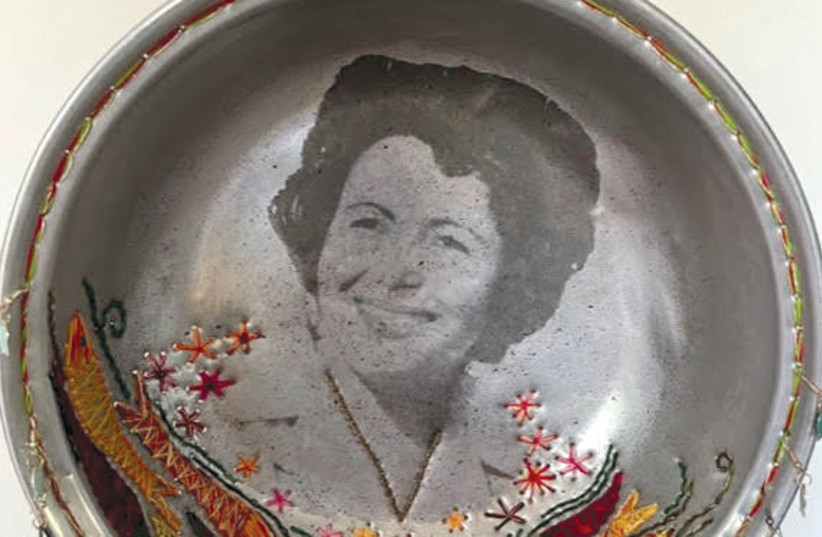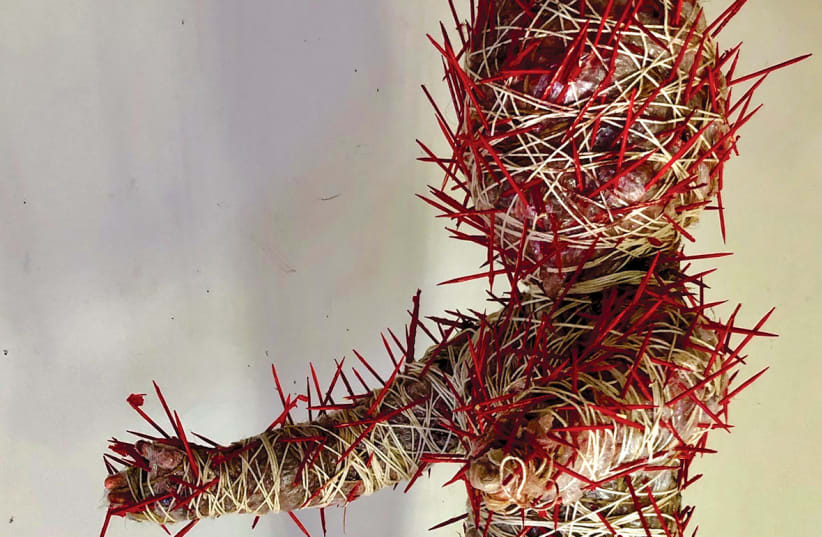
At the crossroads of antiquity and avant-garde stands the Ein Dor Archaeology Museum, where ancient artifacts and modern artworks engage in a provocative dialogue spanning millennia.
“We combine the edges of history,” says Adi Nissenbaum, the curator of the art gallery. “We take the past and present and stitch them together. We are a contemporary art gallery whose exhibits use archaeology as a jumping-off point.”
Nissenbaum selects subjects that captivated the ancients and the modern, although thousands of years separate them.
“By straddling antiquity and the present, we breathe new perspective into rituals, the subject of our new exhibition,” she says.
Founded in 1986, the kibbutz museum is situated near the biblical site of Ein Dor, famed for King Saul’s historic rendezvous with a sorceress on the eve of his final battle against the Philistines.


So, it is fitting that the museum’s new exhibition, Daily Rituals, which opened on January 12, displays some artworks that dialogue with magic and voodoo.
Dealing with magic and voodoo
Juxtaposing relics like an ancient Greek vase depicting scenes of daily living with modern artworks and offering contemporary takes on similar themes, the show aims to uncover new meanings in everyday human and holy rituals.
“The little treasures of everyday life are, in fact, an important ritual,” says Nissenbaum. “They provide meaning and order amidst the chaos of life. Without them, our lives would look entirely different. On the one hand, we transform and sanctify the day-to-day acts; on the other hand, we give holy ceremonies an everyday attitude.”
One artist, Nurit Wolpe, took a mezuzah, traditionally affixed on the door posts of Jewish homes, and replaced the biblical verses from Deuteronomy with Israel’s Declaration of Independence.
“In light of the massive protests against the attempt to change the nature of Israel’s democracy, I thought that each home should have, in addition to the traditional mezuzah, one that is dedicated to secular values,” says Wolpe in the exhibition text.
Tel Aviv artist Dalia Hay Acco tackles the subject of voodoo and the evil eye. A doll found in Kibbutz Be’eri, one of the most brutally hit in the October 7 Hamas attack, hangs from the ceiling, and visitors are invited to stick it with red toothpicks to ward off the evil eye.
Pedart, a group of feminist artists, created a new version of the tefillin – phylacteries traditionally worn by observant Jewish men during morning prayers. The tefillin consists of small black leather boxes and straps. In response to stands in Israeli cities where men are urged to pray but women are excluded, the artists made their feminine version and renamed it “teffilina.” Rather than using the traditional square box shape, they created a translucent pyramid to hold feminist texts that would be visually prominent.
“Both archaeology and contemporary art deal with interpreting fragments or traces of the past,” says Tamar Shooval, the museum’s director and archaeology curator. “Just as archaeologists analyze shards and remnants to reconstruct history, contemporary artists often focus on fragments, memories, artifacts, and traces in modern life and environments. Both attempt to uncover larger meanings.”
The archaeological museum is located in the center of Kibbutz Ein Dor, the first Jewish community founded after statehood, rising from the ground during a lull in the fighting. Among its founding members were Zionist youth movement activists who had immigrated to Israel from the United States, Hungary, and South America. It is nestled in the Lower Galilee in the Jezreel Valley, at the base of Mount Tabor and 11 kilometers from the Sea of Galilee.
The more than 2,000 artifacts discovered in the Jezreel Valley make for a unique local archaeological museum.
In chronological sequence, the permanent archaeology exhibition traces the human footprint from pre-historic flint tools, pottery from various periods, female and male figurines, and jewelry. The most impressive item is a tomb excavated in the 1950s in Kfar Yehoshua, about 30 kilometers away.
How did a kibbutz, with its verdant wheat fields and olive orchards with its members riding around on beaten-up bicycles and the earthy, pungent smell emanating from the dairy, end up with the archaeology museum?
The answer involved a love story.
“Love for archaeology was in the DNA of the founding members of the kibbutz,” says Nissenbaum.
It begins like this. Over the years, while cultivating the land, kibbutz members found that the earth yielded a harvest of ancient artifacts in addition to wheat.
One member, David Ben Nachum, an immigrant from Detroit, was especially dedicated to archaeology and collected all the artifacts found in the surrounding fields. At first, he kept the items under his bed. When he ran out of space, the kibbutz allocated a room where the finds were stored and sorted according to the periods.
“Everyone on the kibbutz understood the importance of preserving the antiquities,” says Shooval.
The first discovery in the field was a Roman-era sculpture of a man’s head, part of a tombstone. The story goes that the man who unearthed it while clearing the land shouted:” Oh my God, this stone is looking at me!”
Then archeologist Carmela Arnon came to nearby Tel Quishion to dig with renowned ancient pottery expert Ruth Amiram. Among other finds, they uncovered the remains of a Bronze Age building.
Some kibbutz members, including Dov Arnon, volunteered in the dig,
“Dov and Carmela fell in love, and Carmela stayed in the kibbutz. All the members who love archaeology asked her to establish a museum. She had worked in the Israel Museum in Jerusalem,” says Shooval. “It was an amazing idea.”
Arnon directed the museum for 40 years and is now retired in the kibbutz.
Love also brought Shooval to Ein Dor. She married the grandson of Ben Nachum, the kibbutz pioneer who had collected the archaeological artifacts under his bed.
The kibbutz provided the funds for establishing the museum, which is now an independent NGO. Members had to decide whether to spend German reparation money to build a museum or a sports hall.
To this day, there is no sports hall in the kibbutz.
“One of the most interesting things we discuss in the museum when we look at the artifacts left behind by the ancients is that this place was multicultural. Pagans, Jews, and later, Christians and Muslims lived here in the Jezreel Valley, and now Circassians and Druze,” says Shooval.
Looking at the multicultural artifacts from the past, the museum’s founder, Carmela Arnon, and the museum’s staff launched a project in 1996 to bring children of different religious and ethnic groups together. It started with elementary school and has grown to thousands of students yearly, including high school.
This year’s project, called Eco Play, brings together Jewish and Arab students to build an ecological park in an Arab village a kilometer away from the museum.
The village, Kfar Misr, has been inhabited since at least the late Roman period, with archaeological excavations, including a 3rd-century synagogue, indicating the presence of Jewish, Christian, and Muslim communities at various periods.
“It’s part of our agenda to make the children, who live close to each other, know their neighbors,” says Nissenbaum.
“The Jewish kids don’t speak Arabic, and the Arab kids don’t speak Hebrew well. We want the meetings to be normal. It’s a big deal, but we try not to make a big deal of it,” she says.
Children will work together to design, build, and maintain the ecological park. In doing so, Nissenbaum hopes they gain an appreciation for their shared environment and heritage and form meaningful bonds that promote understanding between communities.
The Eco Play project connects with the museum’s mission and with one of the works currently displayed in the Daily Ritual exhibition, Bobonnier, by Michal Blayer. Since childhood, Blayer has seen “the sparkling beauty” of nature and has collected stones, shells, seashells, bark – the “remains of life” that capture moments of wonder.
Presented in a Ferrero Rocher box, her assortment evokes a box of chocolates – each imbued with magical potential. Just as Blayer discovers and collects fragments of nature’s magic, the Ein Dor Museum hopes to unearth the fragile yet wondrous foundations of friendship between neighboring communities.
By bringing Jewish and Arab children together to collaborate on an ecological park, the museum hopes to plant seeds of understanding. “The museum’s mission is to excavate not just layers of stone and clay left by the ancients but their stories, daily lives, and rituals,” says Nissenbaum. “Today, we bring children to learn about their mutual past as a bridge for a better present and a shared future.” ■












